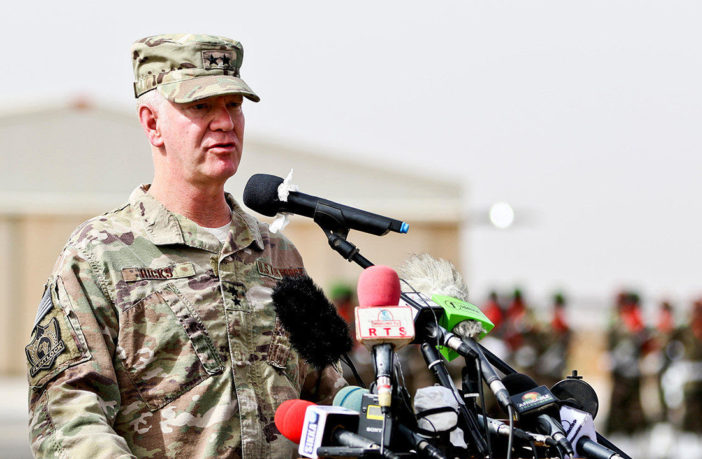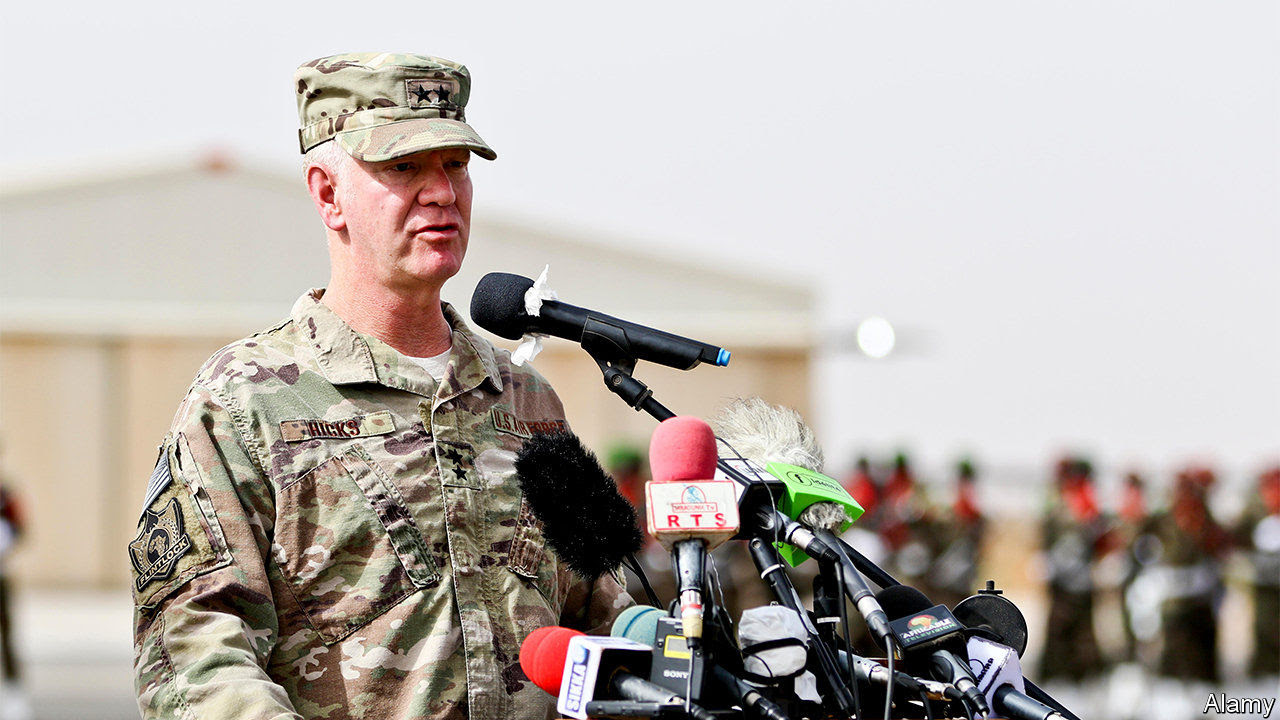The Economist
The Economist talks with the commander of America’s Special Operations Command Africa
MAJOR GENERAL MARK HICKS, who commands about 1,200 special-operations troops assigned to missions in Africa, spoke with The Economist in Niger on April 9th on the sidelines of Flintlock, a military training exercise. He was joined in the discussion by several members of his staff. Below is a transcript of parts of the interview. It has been lightly edited for clarity. Some of General Hicks’s comments are included in an Economist report on security in the Sahel that can be found . A leader on the issue is available .
The Economist: What is your area of biggest concern at the moment?
General Hicks: I’m concerned about youth bulges in Africa. I’m concerned about the growing Salafist threats across Africa and particularly al-Qaeda’s ability to co-opt existing ethnic tensions and other rivalries that are driven by climate change, desertification, scarcity of resources and population pressure. My concern is that we, the West, may fail to take the opportunity to deal with these challenges or help our African partners deal with these challenges of mutual concern while they are still in a nascent stage and can be dealt with at a price that’s affordable in both blood and treasure.
Get our daily newsletter
Upgrade your inbox and get our Daily Dispatch and Editor’s Picks.
The Economist: You talk about the Salafist threat. How much of a threat at the moment is that to Western interests?
General Hicks: We’re seeing an increasing number of threats to Western interests, particularly in Africa, and then I think the game is to keep the threats to Western interests reduced and not wait till we have clear unambiguous evidence of threats to the West outside of Africa. But that’s the challenge of trying to maintain the political will to deal with these threats before they become direct external threats.
The Economist: You’re covering a big part of the world with a very light footprint. How far can you shift the dial?
General Hicks: Only time will tell. My ability to speculate is pretty limited, but given the forces that we have, our real strength is the approach of by, with, and through African and Western partners. So if you look at Flintlock, we have 12 other Western partners down here paying their own way and helping train African partners to deal with threats that are of mutual concern, to Africans and Westerners. They are more proximate threats to our African partners and they want to deal with them on their own but they ask for our help in doing that.
So it’s I think a good model where a light footprint that is affordable and sustainable by the US military and US special operations will be able to leverage a much larger capability and capacity both on the Western partner side and with our African partners. If that will be enough, I don’t know. But it’s going to take more than military pressure. It’s going to take governance and development and the whole-of-government approach to deal with the challenges we see.
The Economist: What about the Democratic Republic of Congo?
General Hicks: The DR Congo is trending badly. But generally speaking, my limited mandate on the continent of Africa is to deal with Salafist jihadist threat where it exists. [In the DRC] the reach of Salafist organisations is limited. In north-eastern Congo, there is some Salafist penetration that we keep an eye on. But I have a small footprint and I have to focus on those things that really are the transnational threats of ISIS and al-Qaeda and where they exist.
I’m sensitive to those who would look at me as militarily incentivised to claim everything is an ISIS problem and therefore, I need resources. We don’t do that. I think we are being very good about not being histrionic over every organisation that claims affiliation with ISIS to gain whatever wasta [Arabic for influence or status] that might provide them. And that, we are pretty diligent about making sure that there is some connection that bestows on them some lethality that we need to be concerned about before we worry about them. And I think we try to be honest in our assessments.
The Economist: How joined up are these groups?
General Hicks: As we in the US military in particular acknowledge that these are trans-regional threats that don’t respect national borders or any other demarcation that we might want, it then becomes an obvious strategic imperative to keep isolated Salafist groups isolated so that they don’t become larger monolithic groups or don’t share either tactics and techniques or resources. But generally speaking, we worry to make sure that they don’t get connected.
I think Barnawi [Abu Musab al-Barnawi, the leader of Islamic State West Africa Province] in particular isn’t. While certainly not contained militarily he is very isolated geographically and there is limited interaction with other organisations, particularly al-Qaeda and AQIM [al-Qaeda in the Islamic Maghreb, an al-Qaeda affiliate with mainly Algerian recruits] or JNIM [Jama’at Nasr al-Islam wal Muslimin, another al-Qaeda outfit in Mali] in the Western Sahara, and we want to keep it that way. However, I think the great question is how the proliferation of cell phones and digital technology allows them to gain knowledge virtually and become much more dangerous. And we’re still struggling with the transfer of money and resources and it doesn’t take a lot in some of these places to make a big difference. So it’s something we pay attention to and we’d love to have a much better understanding of what that all ultimately entails.
Jami Forbes, a senior intelligence analyst with Special Operations Command Africa: I think something that’s of concern to us is the interconnectedness of al-Qaeda groups in particular with regards to their messaging. So a good example of this is over the past year, we’ve seen AQIM and AQAP [al-Qaeda in the Arabian Peninsula] release joint statements. We’ve seen al-Shabaab and AQAP release statements about things like the Rohingya or the closure of the Golden Mosque in Sinai. So there is some attempt probably to make these groups more interconnected and that is enabled by social media and that’s something that we certainly don’t want to happen.
The Economist: How much of it this is purely a kind of battle of ideas?
General Hicks: Again, one of the larger questions out there is how much of this has to do with battles over resources where people co-opt Salafist movements as much as they are co-opted by them. I don’t know that we have a clear picture of how much of this is truly a battle of ideas. But I think there’s enough of it that we’re seeing when regional separatist groups glom on to either al-Qaeda or ISIS, they become much more dangerous, much more capable, and much more emboldened. And it changes their recruiting profile and their ability. It gives them a much deeper pool of recruitment. My sense is that the groups that claim allegiance to ISIS or al-Qaeda do derive some real tangible, very dangerous benefit from that.
The Economist: How much of the benefit is just the branding effect that brings in the recruits and how much are they then learning from one another?
General Hicks: I think they’re learning things. We found that if you put a Special Forces Operational Detachment Alpha of 12 guys out with a battalion of a few hundred indigenous soldiers, they [the indigenous soldiers] become much more capable.
We’re seeing something like that on the flipside where it’s a handful of foreign fighters or returning jihadists, or those who have gained some information and insight from the internet, make otherwise regional separatist groups much more dangerous. It is impossible to quantify but we’re certainly seeing that effect. And it’s an outsized return; they make these groups much more dangerous. So there is something to it more than just the brand. And when it is just a brand, we don’t get that excited about it. There are some who claim to be affiliated that we think they’re stretching it and we can tell.
The Economist: Thank you.








